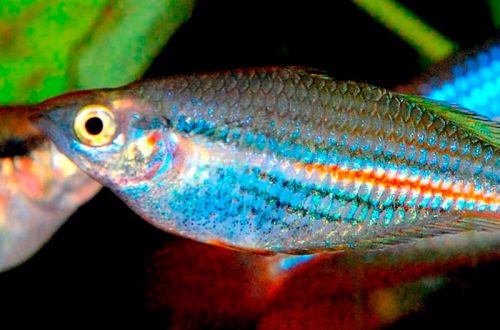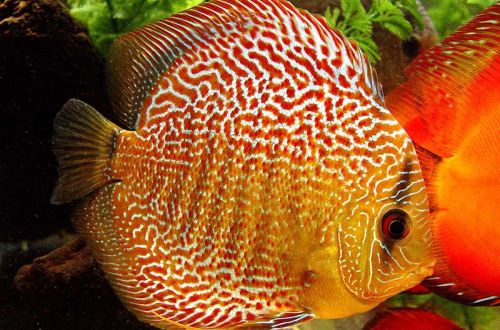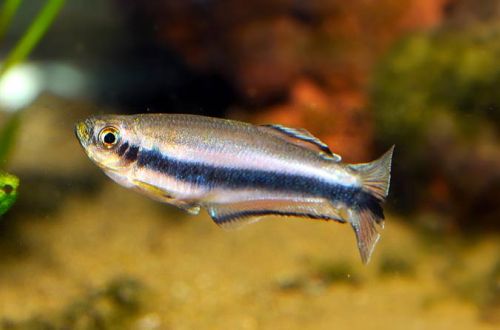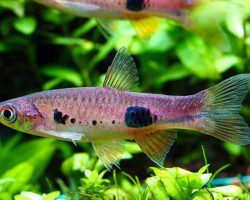
Melanotenia papua
Papua Melanothenia, scientific name Melanotaenia papuae, belongs to the family Melanotaeniidae (Rainbows). The fish is native to Papua New Guinea, where it is found in numerous streams on the southern tip of the island.

Contents
Description
Adults reach a length of about 6 cm. The fish has a typical rainbowfish body shape with a characteristic forked dorsal fin. When kept in favorable conditions and a balanced diet, bluish-green hues predominate in color. Otherwise, the color becomes gray.
Horizontal black and red stripes run along the body, most visible in the tail. In males they are more contrasting, in females they look paler.
Behavior and Compatibility
Mobile peaceful fish. They prefer to be in the company of relatives in a flock of 6-8 individuals. Compatible with most other types of comparable size.
However, when choosing tankmates, you should avoid slow-moving fish that such active Melanothenia can cause concern.
Brief information:
- The volume of the aquarium – from 100 liters.
- Temperature – 22-32°C
- Value pH — 7.2–7.8
- Water hardness – medium and high hardness (10-20 dGH)
- Substrate type – any
- Lighting – moderate, bright
- Brackish water – no
- Water movement – weak, moderate
- The size of the fish is about 6 cm.
- Food – any food
- Temperament – peaceful
- Keeping in a flock of 6-8 individuals
- Life expectancy about 5 years
Maintenance and care, arrangement of the aquarium
The optimal size of an aquarium for a flock of 6-8 fish starts from 100 liters. The decoration is arbitrary, but it is important to provide large free areas for swimming and places for shelters, so it is recommended to place decoration elements along the side and rear walls of the tank.
Fish tend to jump out of the aquarium. For this reason, it is worth creating barriers, for example, from a cover and plants floating on the surface.
Needs clean running water rich in oxygen. They are able to adapt to life in a wide range of dGH values, but prefer water above neutral pH values (weakly alkaline).
With long-term maintenance, it is necessary to ensure high water quality, which depends not only on the smooth operation of the filtration system, but also on the regular maintenance of the aquarium. In particular, it is required to replace part of the water with fresh water weekly and remove accumulated organic waste.
Being a native of flowing water bodies, Papua Melanothenia is sensitive to the oxygen content in the water. In addition to the filter, if it is not equipped with an aeration system, it is worth placing a few spray stones.
Food
Captive-bred fish are trained to accept most popular dry foods. A balanced diet of high quality foods will bring out the best colors in the coat.
Reproduction / breeding
Breeding Papua Melanothenia requires some experience. It will be difficult for a novice aquarist without additional knowledge to carry out the process of obtaining juvenile fish.
The fish reach sexual maturity at about one year of age. Breeding is carried out in a separate small aquarium. Where the most colorful males and several large females are placed. The diet includes live or frozen food. A month after transplanting, the temperature is gradually increased by a couple of degrees – this serves as an incentive for spawning.
If the fish are ready, then one day at dawn they lay more than a hundred eggs among the thickets of plants. Spawning may take several days.
The fish do not show parental care and may eat their own eggs. For this reason, they need to be moved back to the common aquarium in a timely manner.
The fry appear throughout the week. In the first days of life, they feed on the remains of their yolk sac while in place. Then they begin to swim freely in search of food. Feed with specialized food for juvenile aquarium fish, Artemia nauplii and other micro food.





